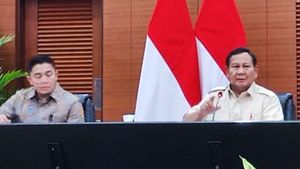JAKARTA - Today, January 25 to be precise, Indonesia commemorates National Nutrition Day. National Nutrition Day is commemorated to remember the recruitment of Indonesian nutrition workers with the establishment of the School of Food Warriors by LMR on January 25, 1951.
According to the official website of the Ministry of Health of the Republic of Indonesia, Sehat Negeriku, since then nutrition education has continued to develop rapidly in many universities in Indonesia. After that it was agreed on January 25 as Indonesia's National Nutrition Day.
National Nutrition Day was first held by the People's Food Institute (LMR) in the mid-1960s. The commemoration was then continued by the Directorate of Community Nutrition since the 1970s until now.
Efforts to improve nutrition in Indonesia began in 1950, when the Minister of Health, Doctor J Leimena, appointed Professor Poorwo Soedarmo as the head of the People's Food Institute (LMR) or at that time better known as the Voor Volksvoeding (IVV) Instituut. For decades, struggling to improve nutrition in Indonesia does not mean that the struggle will end soon.
Stunting rate in IndonesiaStunting, the impact of malnutrition on children under five still haunts Indonesia. In 2019, the then Indonesian Minister of Health, Nila F. Moeloek, said that the stunting rate in 2019 fell to 27.67 percent.
This decrease is based on the 2019 Prevalence of Stunting Data from the results of research on the nutritional status of children under five in Indonesia. This figure is good news because the decline in stunting rates is considered very encouraging.
When compared to stunting data based on Basic Health Research (Riskesdas) in 2018, the figure reached 30.8 percent. Even though the stunting rate has decreased, this figure is still above the limit set by WHO.
The WHO tolerance limit for stunting is 20 percent. Most cases of stunting are in areas with high poverty and low levels of education.
Seeing the decline in stunting rates in Indonesia gives hope for the Indonesian government to continue to reduce it. The President of the Republic of Indonesia Joko Widodo (Jokowi) is targeting the stunting rate in 2024 to fall to 14 percent.

With this target, Jokowi ordered his staff to focus on reducing stunting rates, especially in ten provinces, where the stunting prevalence rate is the highest in Indonesia. The ten provinces are NTT, NTB, West Sulawesi, Gorontalo, Aceh, Central Kalimantan, South Kalimantan, West Kalimantan, Southeast Sulawesi and Central Sulawesi.
"Later the Minister of Home Affairs can also convey governors, regents and mayors to the village heads, especially for the 10 provinces, so that they can really concentrate and focus on reducing stunting," said Jokowi, as reported by VOI.
Jokowi also asked for access to health services for pregnant women and toddlers at the Puskesmas or Posyandu to continue running as usual amid the COVID-19 pandemic. Jokowi also hopes that the promotional and educational aspects of socialization for pregnant women and their families will continue to be intensified to increase understanding of stunting prevention.
In addition, the Coordinating Minister for Human Development and Culture (Menko PMK) Muhadjir Effendy also reminded that extraordinary steps must be taken to achieve this ambitious target. One of them is cooperating with the National Population and Family Planning Board (BKKBN) to prevent stunting before marriage occurs.
The English, Chinese, Japanese, Arabic, and French versions are automatically generated by the AI. So there may still be inaccuracies in translating, please always see Indonesian as our main language. (system supported by DigitalSiber.id)













